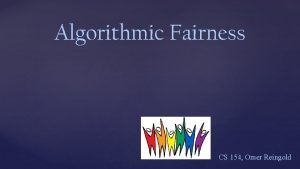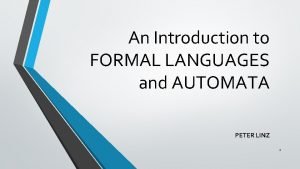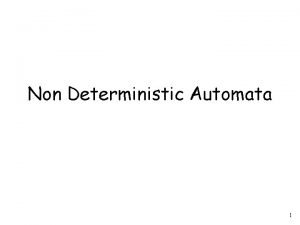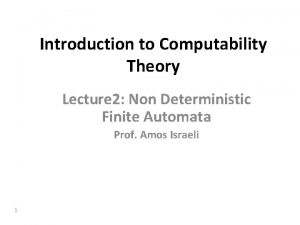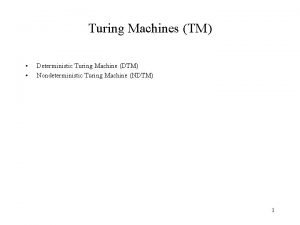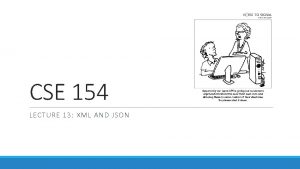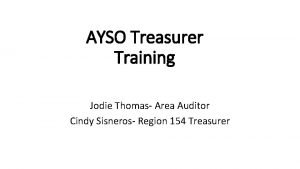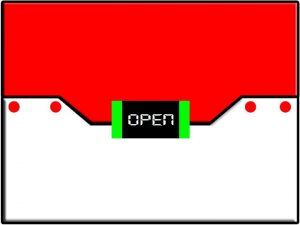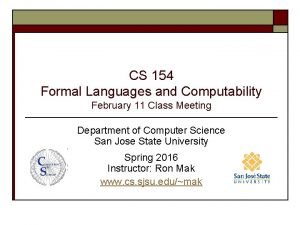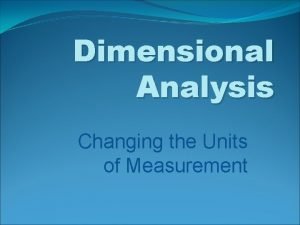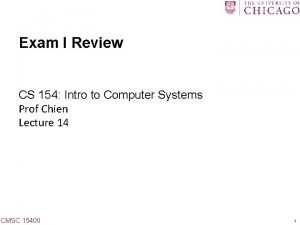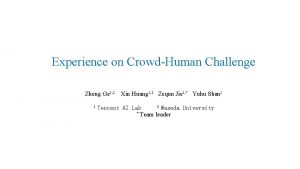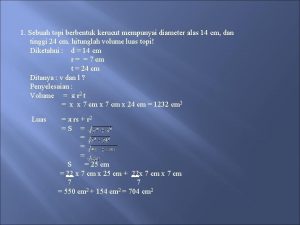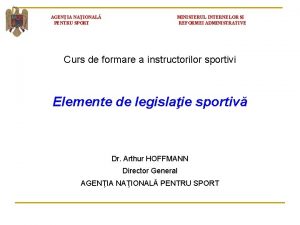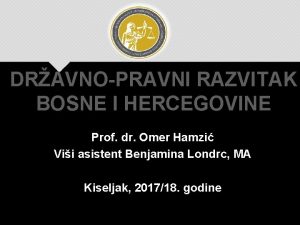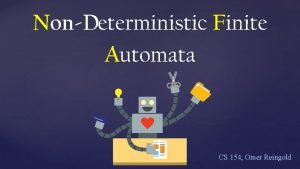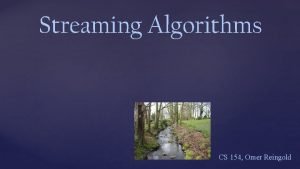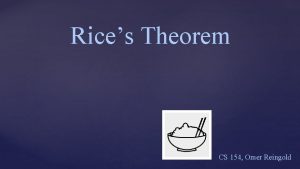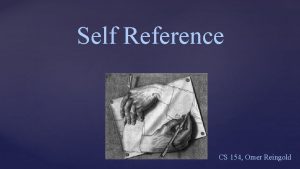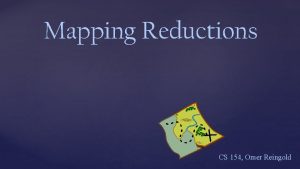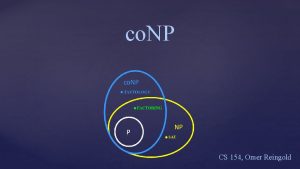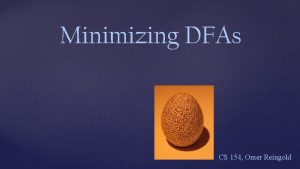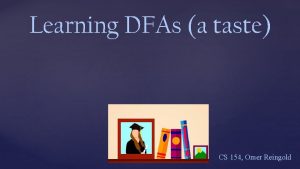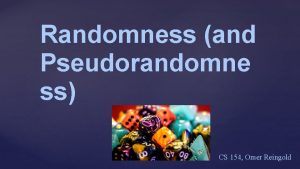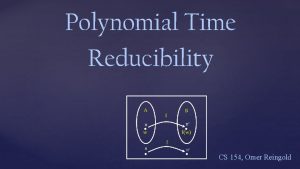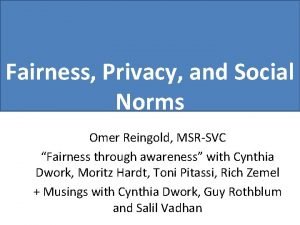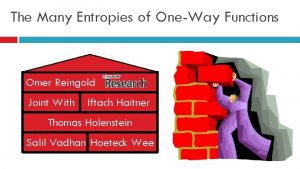P vs NP CS 154 Omer Reingold Nondeterministic
























- Slides: 24

P vs NP CS 154, Omer Reingold

Nondeterministic Turing Machines …are just like standard TMs, except: 1. The machine may proceed according to several possible transitions (like an NFA) 2. The machine accepts an input string if there exists an accepting computation history for the machine on the string


Definition: A nondeterministic TM is a 7 -tuple T = (Q, Σ, Γ, , q 0, qaccept, qreject), where: Q is a finite set of states Σ is the input alphabet, where Σ Γ is the tape alphabet, where Γ and Σ Γ : Q Γ → 2(Q Γ {L, R}) q 0 Q is the start state qaccept Q is the accept state qreject Q is the reject state, and qreject qaccept

Defining Acceptance for NTMs Let N be a nondeterministic Turing machine An accepting computation history for N on w is a sequence of configurations C 0, C 1, …, Ct where 1. C 0 is the start configuration q 0 w, 2. Ct is an accepting configuration, 3. Each configuration Ci yields Ci+1 Def. N(w) accepts in time t Such a history exists N has time complexity T(n) if for all n, for all inputs of length n and for all histories, N halts in T(n) time

Definition: NTIME(t(n)) = { L | L is decided by a O(t(n)) time nondeterministic Turing machine } TIME(t(n)) NTIME(t(n)) Is TIME(t(n)) = NTIME(t(n)) for all t(n)?

What problems can we efficiently solved nondeterministically, but not deterministically?

The Clique Problem a d f e g c b k-clique = complete subgraph on k nodes

The Clique Problem Find a clique of 1 million nodes?

Assume a reasonable encoding of graphs (example: the adjacency matrix is reasonable) CLIQUE = { (G, k) | G is an undirected graph with a k-clique } Theorem: CLIQUE NTIME(nc) for some c > 1 N((V, E), k): Nondeterministically guess a subset S of V with |S| = k For all u, v in S, if (u, v) is not in E then reject Accept

The Hamiltonian Path Problem f b e g a i d c h A Hamiltonian path traverses through each node exactly once

HAMPATH = { (G, s, t) | G is a directed graph with a Hamiltonian path from s to t } Theorem: HAMPATH NTIME(nc) for some c > 1

Nondeterministic Polynomial Time NP = k NTIME(n ) k N

Theorem: L NP There is a constant k and polynomial-time TM V such that L = { x | y ϵ Σ* [|y| ≤ |x|k and V(x, y) accepts ] } Proof: 1. If L = { x | y |y| ≤ |x|k and V(x, y) accepts } then L NP Define the NTM N(x): Guess y of length at most |x|k Run V(x, y) and output answer Then, L(N) is the set of x s. t. [|y| ≤ |x|k & V(x, y) accepts] (2) If L NP then L = { x | y |y| ≤ |x|k and V(x, y) accepts } Suppose N is a poly-time NTM that decides L. Define V(x, y) to accept iff y encodes an accepting computation history of N on x

A language L is in NP if and only if there are polynomial-length proofs (aka. certificates or witnesses) for membership in L CLIQUE = { (G, k) | subset of nodes S such that S is a k-clique in G } HAMPATH = { (G, s, t) | Hamiltonian path in graph G from node s to node t }

Boolean Formula Satisfiability logical operations parentheses = ( x y) z Boolean variables (0 or 1) recedes precedes

Boolean Formula Satisfiability = ( x y) z A satisfying assignment is a setting of the variables that makes the formula true x = 1, y = 1, z = 1 is a satisfying assignment for (in fact, any assignment with z = 1 is satisfying) = (x y) (z x) 0 0 1 0

A Boolean formula is satisfiable if there is a true/false setting to the variables that makes the formula true YES a b c d NO (x y) x SAT = { | is a satisfiable Boolean formula }

A 3 cnf-formula has the form: (x 1 x 2 x 3) (x 4 x 2 x 5) (x 3 x 2 x 1) literals clauses 3 SAT = { | is a satisfiable 3 cnf-formula }

3 SAT = { | is a satisfiable 3 cnf-formula } Theorem: 3 SAT NP We can express 3 SAT as 3 SAT = { | is in 3 cnf and string y that encodes a satisfying assignment to }

NP = Problems with the property that, once you have the solution, it is “easy” to verify the solution When ϵ SAT, or (G, k) ϵ CLIQUE, or (G, s, t) ϵ HAMPATH, Can prove that with a short proof that can easily been verified

P = the problems that can be efficiently solved NP = the problems where proposed solutions can be efficiently verified Is P = NP? can problem solving be automated? Clay Math Institute in the year 2000: “millennium problems”

If P = NP: Mathematicians may be out of a job Cryptography as we know it may be impossible In principle, every aspect of life could be efficiently and globally optimized … life as we know it would be different! Conjecture: P NP

Parting thoughts: Polynomial Time: Verifying vs. Deciding
 Omer reingold
Omer reingold Omer reingold
Omer reingold Pushdown automata
Pushdown automata Nondeterministic means choice of moves for automata *
Nondeterministic means choice of moves for automata * Convert nfa to dfa
Convert nfa to dfa Nondeterministic
Nondeterministic Nondeterministic turing machine
Nondeterministic turing machine Inst154
Inst154 Cse 154
Cse 154 Ayso nap online
Ayso nap online Dodo akan memberi kado ulang tahun buat desi
Dodo akan memberi kado ulang tahun buat desi Gfr 154 certificate
Gfr 154 certificate Homework 154
Homework 154 Cs 154 sjsu
Cs 154 sjsu Dimensional analysis steps
Dimensional analysis steps Uchicago cs 154
Uchicago cs 154 Cs 154 stanford
Cs 154 stanford Al baqarah 154-157
Al baqarah 154-157 Senet154
Senet154 Inst154
Inst154 Cse 154
Cse 154 Sebuah kerucut mempunyai volume 36cm3
Sebuah kerucut mempunyai volume 36cm3 Ordinul 154 din 2004
Ordinul 154 din 2004 Equal protection for english language learners
Equal protection for english language learners Dr omer
Dr omer

